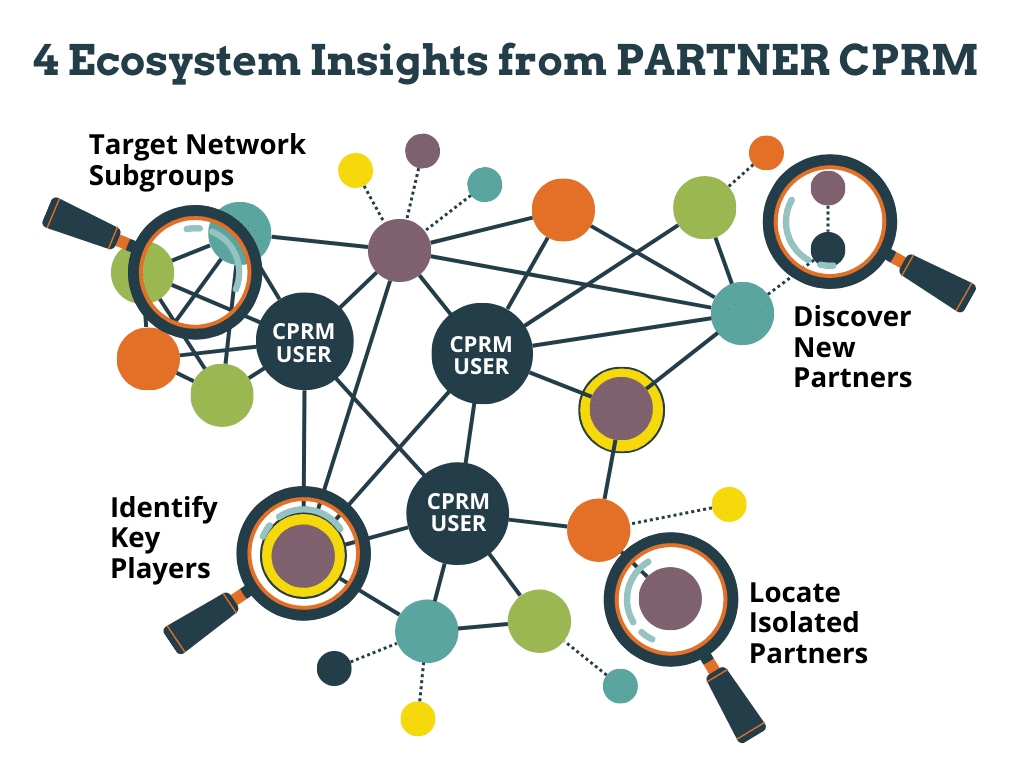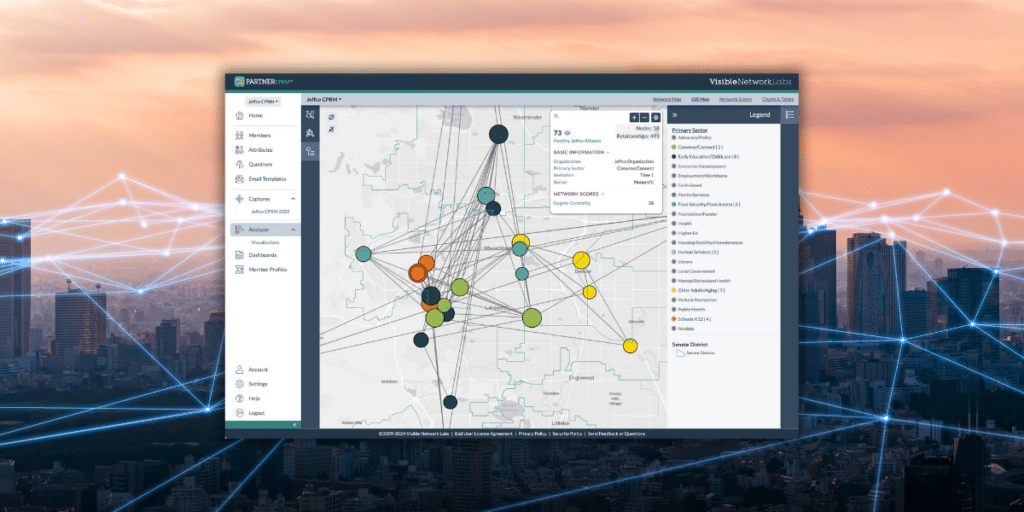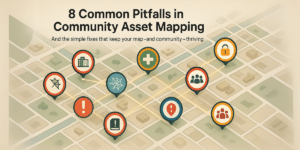The FSG blog article “Embracing an Ecosystem Approach for Philanthropy” eloquently highlights a critical shift in the philanthropic landscape. Funders are moving away from being the epicenter of social change and are increasingly positioning themselves as facilitators, connectors, and learners within a broader ecosystem. This shift aligns closely with the capabilities of the PARTNER CPRM (Community Partner Relationship Management) platform, making it an invaluable tool for those adopting an ecosystem approach to philanthropy.
In this article, we will explore how PARTNER CPRM and ecosystem mapping can support and enhance the strategies outlined by FSG, particularly in strategy development, implementation, and evaluation.
Table of Contents
1. Using Ecosystem Mapping as a Strategic Tool
At the heart of the ecosystem approach is the recognition that funders are part of a larger network of stakeholders, all of whom contribute to systems change. This requires a deep understanding of the relationships, resources, interactions and influence within this network. The PARTNER CPRM platform is designed to facilitate this understanding through its powerful ecosystem mapping and social network analysis (SNA) capabilities.
Using PARTNER CPRM, funders can create visual maps of their networks, identifying key actors, the nature of their relationships, and the flow of resources and information within the ecosystem. These maps are not static; they can be updated as relationships evolve and new stakeholders emerge. This dynamic mapping capability aligns with FSG’s view that strategy in complex systems must be adaptive, serving as a compass rather than a map.
By regularly updating the ecosystem map within PARTNER CPRM, funders can adjust their strategies in real-time, ensuring that their efforts remain aligned with the shifting landscape of their ecosystem.
Examples of Ecosystem Mapping Strategic Insights
Here are a few examples of how this process can lead to actionable strategic insights and lessons for those engaged in trust-based philanthropy to shift systems for transformative impact:
- Example 1: Identifying Key Influencers – Through ecosystem mapping, a funder discovers that a small grassroots organization has unexpectedly high influence within the community. This insight leads to a strategic decision to provide capacity-building support to this organization, amplifying its impact across the network.
- Example 2: Bridging Gaps – The visual representation of the ecosystem reveals a disconnect between healthcare providers and community outreach programs. The funder uses this information to facilitate new partnerships, improving the overall effectiveness of health initiatives in the area.
- Example 3: Resource Analysis – By mapping the availability of resources and value within the ecosystem, a funder identifies overlaps and gaps in funding. This leads to a more coordinated approach among multiple funders, ensuring resources are distributed more equitably and efficiently across the system.

2. Supporting Strategy Implementation with Ecosystem Mapping
FSG emphasizes the importance of funders acting as partners and deep listeners, working closely with grantees and community members to co-create solutions. PARTNER CPRM supports this by providing tools for data collection and analysis that are rooted in collaboration and trust.
The platform’s default survey questions, for instance, are designed to gather insights from network members about their perceptions, trust levels, and value creation within the network. This data can be analyzed to identify gaps in trust or communication, allowing funders to address these issues proactively. By facilitating open dialogue and data-driven decision-making, PARTNER CPRM helps funders to implement strategies that are not only effective but also reflective of the collective wisdom of the ecosystem.
Furthermore, the platform’s reporting features enable funders to share insights and feedback with their partners, fostering a culture of transparency and mutual accountability. This aligns with the ecosystem approach where funders cede some control to empower community-led initiatives.
Examples of Ecosystem Mapping Insights for Implementing Strategy
Here are some examples of how organizations can implement strategy through deep listening and collaboration using PARTNER CPRM and SNA:
- Example 1: Community Health Initiative – A healthcare foundation uses PARTNER to survey local clinics, community organizations, and residents about health challenges. The data reveals a lack of trust between clinics and community groups. The foundation organizes collaborative workshops, using PARTNER CPRM’s reporting features to share data, leading to improved communication and joint health education programs.
- Example 2: Environmental Conservation Project – An environmental nonprofit utilizes SNA to map relationships between various stakeholders in a watershed protection effort. The ecosystem map highlights disconnects between policymakers and local farmers. The nonprofit facilitates dialogue sessions, sharing network data to illustrate interdependencies, resulting in more inclusive policy development.
- Example 3: Education Reform Initiative – A education-focused foundation employs PARTNER CPRM to gather insights from schools, parents, and community leaders about educational needs. The platform’s trust metrics reveal low confidence in the organization. The foundation adjusts its strategy, organizing community listening sessions and co-creation workshops.

Get our monthly newsletter with resources for cross-sector collaboration, VNL recommended reading, and upcoming opportunities for engaged in the “network way of working.”
3. Continuous Learning and Adaptation Through Ecosystem Mapping
One of the challenges in adopting an ecosystem approach, as noted by FSG, is the need for continuous learning and adaptation. Traditional evaluation methods, which focus on accountability and impact at the grant level, are insufficient in a systems change context. Instead, funders need tools that enable ongoing learning and flexibility.
PARTNER CPRM’s network analysis features allow funders to track changes in their ecosystem over time. By regularly analyzing network metrics—such as centrality, density, and connectivity—funders can assess the health of their ecosystem and identify emerging trends or challenges. This ongoing analysis supports a learning-oriented approach to evaluation, where the focus is on understanding the dynamics of the ecosystem rather than merely measuring outputs.
Moreover, the platform’s ability to integrate qualitative data—such as stories of change or community feedback—provides a richer, more nuanced understanding of how systems change is occurring. This aligns with FSG’s call for a reorientation of learning and evaluation towards a system-focused lens, where the primary goal is to adapt and refine strategies in response to new information.
Examples of Continuous Learning and Adaptation
Here are some examples of how PARTNER CPRM can facilitate continuous learning and adaptation in ecosystem-based philanthropy:
- Example 1: Tracking Network Evolution – A funder analyzes network density over time. They notice an increase in connections among previously isolated groups, indicating successful relationship-building efforts. This insight leads to a decision to focus on nurturing these emerging collaborations.
- Example 2: Identifying Emerging Leaders – Through regular network analysis, a foundation discovers a shift in centrality measures, revealing new influential actors in the ecosystem. This prompts the funder to engage these emerging leaders and adjust their capacity-building strategy accordingly.
- Example 3: Adaptive Resource Allocation – By monitoring changes in reported trust and value creation within the network, a funder identifies areas where their support has been most impactful. They use this information to refine their funding priorities, directing resources to initiatives that show the greatest potential for systems-level change.

Conclusion: PARTNER CPRM as a Catalyst for Ecosystem-Based Philanthropy
Ecosystem mapping and PARTNER CPRM is a powerful to support system change philanthropic strategies, equipping funders with the capabilities they need to understand, engage, and learn from their ecosystems. Through advanced ecosystem mapping, collaborative strategy implementation, and adaptive learning, PARTNER CPRM empowers funders to transcend traditional, top-down approaches and embrace their role as facilitators of systems change.
Take the Next Step and See It For Yourself
If you’re ready to explore how PARTNER CPRM can enhance your philanthropic efforts and drive meaningful, lasting change within your ecosystem, we invite you to learn more about our platform.
Request a demo today to see how PARTNER CPRM can support your journey toward impactful systems change.






